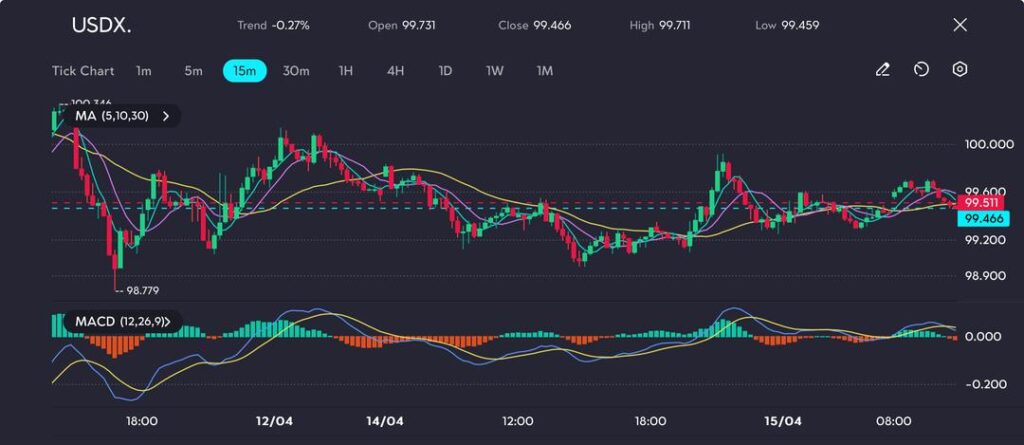
Key Points
- Dollar Index (USDX) hovers at 99.466, close to the three-year low touched last week.
- U.S. dollar is down nearly 8% against the Swiss franc this month, on pace for its steepest drop since 2008.
- Fed’s Waller signals rate cuts could be considered even if inflation remains elevated due to tariff-related shocks.
The U.S. dollar steadied in early Tuesday trade but remained fragile, clinging to support near multi-year lows following a whipsaw week of tariff policy reversals and investor rotation out of dollar assets. The Dollar Index (USDX) settled at 99.466, down 0.27% on the day, after a volatile stretch that saw it plunge to its lowest level since July 2023, despite Treasury yields hitting 20-year highs last week.
Much of the damage to the dollar has come from Washington’s flip-flopping on tariffs. President Trump backpedalled after announcing sweeping import duties, removing some high-profile Chinese consumer goods from the list over the weekend. Markets welcomed the move, but Trump’s suggestion that the relief would be temporary further unsettled traders.
The Swiss franc surged to a 10-year high against the greenback last week. Meanwhile, the yen and euro remain firm, despite some pullback today. The euro traded at $1.1324, just below its three-year high of $1.1474, and the yen at 143.53, only slightly above Friday’s six-month low of 142.05.
Technical Analysis
The US Dollar Index (USDX) continues to consolidate in a tight range following a volatile dip to 98.779 on April 12. Since then, price has stabilised, finding a temporary floor above the 99.20–99.30 zone, but upside attempts remain shallow and short-lived, with 99.71 marking the recent local high. The price has since retraced toward 99.46, now hovering near the 5/10/30 MA cluster, suggesting indecision.

Picture: USDX stalls below 99.75 as bulls hesitate to reclaim lost ground, as seen on the VT Markets app
Momentum indicators are mixed. The MACD histogram has flattened, and the signal lines are entangled near the zero line, indicating a lack of strong directional momentum. With price capped below psychological resistance at 100.00, and no follow-through from earlier rebounds, the index may continue to range trade or test downside supports unless a new catalyst emerges.
A decisive break above 99.75–99.80 could restore bullish sentiment, while a slip below 99.20 may bring 98.77 back into view.
Fed Officials Signal Dovish Pivot
Adding to the dollar’s woes, Federal Reserve Governor Christopher Waller commented on Monday that tariff shocks may require rate cuts, even if inflation stays high—highlighting the unusual policy dilemma the central bank now faces. Traders responded by increasing bets on easing, with 86 basis points of rate cuts priced in for the remainder of the year, according to LSEG data.
Bond markets have calmed slightly, with the U.S. 10-year yield holding steady at 4.354%, after last week’s 50-basis-point surge—the largest since 2001. Analysts see this pause as temporary, given the broader reallocation out of Treasuries and into global alternatives.
Cautious Outlook
With policy direction from Washington remaining inconsistent and the Fed signalling greater tolerance for easing, the dollar faces continued headwinds. Near-term technical support for USDX lies at 98.75, while resistance caps movement at 100.20. If upcoming data—particularly this week’s retail sales and jobless claims—disappoints, the USDX could resume its descent toward mid-2022 levels.









